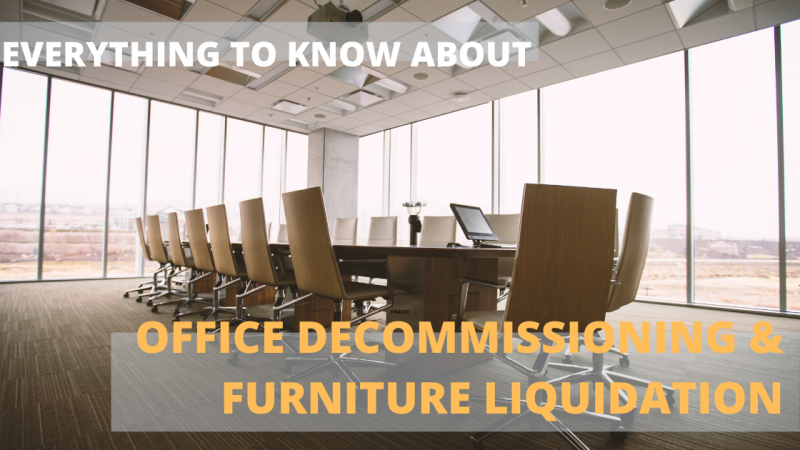Relocating your business? You’re no doubt excited about moving to your new office location! But before you turn over the keys to your old place, be sure to understand the decommission responsibilities that are defined in your lease contract – and how to smoothly liquidate outdated or worn out assets.
Your office exit plan is critical — add these steps to your business moving checklist. If you don’t follow the contract terms, you could forfeit your deposit or become liable for added costs that could quickly add up to thousands of dollars. Use this guide to properly decommission your office and liquidate your furniture.
Decommissioning an Office Space
When you signed your office lease, you became contractually obligated to follow decommission requirements. The decommission clause specifies the condition of the office once you have moved out and hand over the keys.
- Meet with your property manager to confirm the decommissioning requirements of the lease.
- At this meeting, discuss the contract’s lease surrender terms
- If you took photos of the space before you moved in, they’ll be a helpful tool in several ways
- They’ll show you how to restore your office to its original condition
- They’ll provide a standard of comparison when you and the landlord do the final inspection
- Create a timeline
- A timeline will prevent you from having to pay for ‘buy back’ days to complete the decommissioning job
- Coordinate contractors’ schedules to avoid work and space conflicts and use of building resources, freight elevator, loading docks
- Inform building management of timelines and work schedules
- Perform a final walkthrough with property manager
- Sign off contract
- Hand over the keys

Your lease contract should specify the requirements for decommissioning your office.
What Lease Agreements Typically Require
Refer to your lease contract for the precise decommissioning requirements. Decommissioning can be as simple as merely ‘broom cleaning’ the floors. But more commonly, you’re required to restore the office space to its original condition. These are the most common decommissioning requirements included in lease agreements:
- Removal of data and voice cabling
- Removal of MEP (mechanical, electrical, and plumbing) installed after lease was signed
- Removal of FFE (furniture, fixtures, and equipment). This includes workstations, lighting, partitions, etc.
- Cleaning
- Walls
- Floors
- Kitchens
- Restrooms
- Repairs
- Be sure repairs meet the lease contract terms
- Patching or replacing areas of walls, floors, ceilings, or windows in order to restore to original condition
- Sign removal
- E-waste collection and removal
- Trash removal and disposal
- Hazardous waste disposal
- Cancel vendor services (janitorial, water, plant maintenance, coffee, etc.)

Follow the decommissioning requirements to restore the office in its original condition.
Liquidating Furniture and Equipment
Whether you’re relocating to a new office or closing down your business, you’ll need to liquidate assets that you can’t use. The terms of your lease most likely specify that you can’t leave assets at your old office – what do you do with unusable furniture, equipment, work stations, bookshelves, inventory racks, and more? You’ll liquidate them. But consider these important issues before you proceed.
- As you plan asset liquidation, consider your company’s values. Your economic, environmental, and social goals will direct the liquidation process. Does your business favor an employee discounted sale, LEED certification points, sustainability, eco-friendly, zero landfills, or a chosen NGO?
- It’s important that a skilled crew carefully disassembles and removes useable assets so they retain value and purpose – whether they’ll be sold, recycled, donated, or repurposed.
OK, now you’re ready to conduct a comprehensive inventory of your office. Create a chart that specifies how each asset will be managed. Some items will move to the new office; everything else will be liquidated. But liquidation doesn’t always mean the items will be sold. Some assets that can’t be sold can be recycled, repurposed, donated, or hopefully, in as few cases as possible, trashed. Your chart will include the following categories:
- Item will be moved to the new office
- Item will be sold
- Item will be donated
- Item will be recycled
- Item will go in green waste
- Item will be properly disposed of in the hazardous waste
If you’re managing the liquidation on your own, identifying the specific categories will help with a smoother and much easier liquidation. However, liquidating your furniture and assets can seem like an overwhelming task while you’re also managing your office relocation. If you need help, hire professional services. Applemoving.com provides expert office decommissioning and liquidation as part of our commercial moving services. Licensed and insured professionals will affordably and efficiently manage the process for you.
* * *
Get free office moving quotes today! Apple Movers can precisely restore your office space as per your lease agreement and efficiently liquidate FFE according to your business philosophy.


